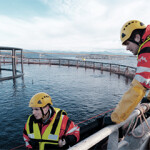Turning an invasive problem into a bait solution
With concerns growing over a likely bait shortage in the lobster industry in Maine and Canada due to a drastic cut in the upcoming season's herring quota, Nova Scotia resident Patrick Swim has a possible solution. Swim thinks he can solve the bait shortage by harvesting an invasive species.
Silver carp is one of the four species of the invasive Asian carp (silver, bighead, grass, and black) that have placed the Great Lakes water system at risk. Carp were brought to North America in the 1970s as a biological control of algae, plants, and snails in aquaculture sites. Subsequent flooding allowed them to escape their pens, which created a new problem for the environment and marine life. A mature meter-long carp can weight 40 kilograms and consume up to 40 percent of their body weight each day, which puts stress on resources for native species. They also reproduce rapidly.
Swim was intrigued by reports that silver carp are so disturbed by noise and vibration caused by boat motors that they jump up to three meters out of the water. While looking at this flying fish phenomenon, Swim, whose family have long fished lobster on Canada's Cape Sable Island, had an idea to harvest the carp, freeze it, cut it into pieces and sell it as a cheap bait to East Coast lobster fishermen.
In the past decades, Asian carp have replaced native fish species in areas of the Mississippi River and its tributaries. Their advance towards the Great Lakes has spurred the U.S. Army Corps of Engineers, U.S. Fish and Wildlife Service, U.S. Coast Guard, U.S. Environmental Protection Agency, and the Illinois Environmental Protection Agency to spend tens of millions of dollars annually trying to contain them. So far, electro-magnetic fields and fish fences have prevented all but a few carp from entering the lakes.
Swim’s vision is to lower the potential of silver carp entering the lakes by harvesting the species for bait. This would help the environment, and take pressure off herring and mackerel, currently the main species used for bait and whose catches have been declining, Swim said. Swim told The Globe and Mail it would also save fishermen money. With the average lobster fisherman buying 40,000 pounds of bait a year, saving a few cents a pound on bait would make a huge difference to them, he said.
“That’s your vacation or your Christmas presents,” he said. “Or whatever USD 4,000 [EUR 3,500] buys, which is a lot for a fisherman.”
Swim’s idea seems straightforward, but Canada is so serious about keeping its waters carp-free that it has fined fish haulers more than CAD 100,000 (USD 76,804, EUR 66,757) for possessing live fish. Swim needs permission from multiple federal and provincial ministries and government agencies in order to make his idea work.
In his quest, Swim has engaged academics, as well as Canada’s Department of Fisheries, Oceans and Coast Guard, zoologists, and other experts. His idea is to catch the carp in vast nets in Illinois, in the United States, then take them to a facility where they are gutted on tables, put in barrels, frozen, and shipped to Nova Scotia.
DFO have provided Swim with a note that said after a review, “There is no prohibition to use that species at this time for lobster bait as long as the fish is dead and eviscerated before it enters Canada, as required under the Aquatic Invasive Species Regulations.”
To further make its point, DFO specified – in underlined, bold italics – that “a slit up the belly of the fish” wasn’t sufficient evisceration. The entrails and organs, including the brain and gills, have to be removed.
Swim promises the fish will be treated this way, and will be dead and frozen for two weeks before it reaches the bottom of the Atlantic.
In addition to this, DFO has warned that permission can be withdrawn if new concerns arise. Swim also must obtain permission from the Canadian Border Services Agency, as well as provincial regulators for each province the fish are transported through, and permits from The Canadian Food Inspection Agency to import dead fish.
If the project receives all the permissions and clearances it needs, the state of Illinois believes hundreds of millions of pounds of Asian carp could be harvested annually from it waters, with 50 million pounds coming directly from the Illinois River.
If the project succeeds, Swim said, “It can do some good on both ends.”






Share